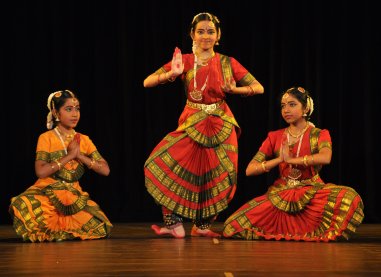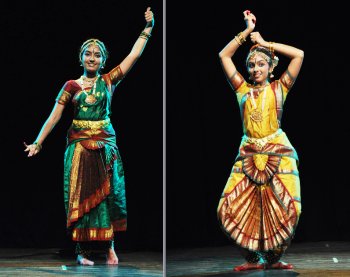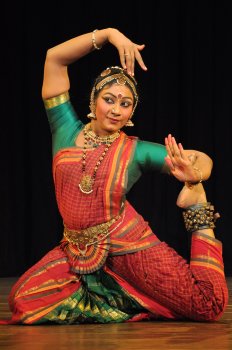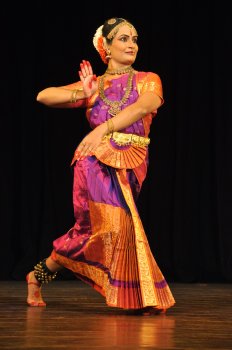
|   |

|   |
Sai Nrityotsava 41 - Chittaranjan Mothikhane e-mail: chittaranjanmothikhane@gmail.com October 12, 2012 When the same people arrive at the prefixed time, occupy their favorite seats, eagerly wait for the dance floor to light up and bring alive the beautiful dance forms of India, savor the melody and movement, be captured in the net of scenarios divine to humane unfold, it is established that Sai Nrityotsava is a much awaited monthly dance festival. The 41st in its series was showcased on 1st October 2012 at Seva Sadan, Bangalore, with focus on Bharatanatyam. Pushya Pradeep presented junior dancers of Sai Arts International, Aditi, Jyothsna, Keerthana, Pallavi, Shweta C, Shweta M, Varuni and Anusha in the opening segment. The young artistes strung together a pushpanjali, Ganesha Kouthvam and Natesha Kouthvam, all in Naata raga set to adi tala that made an auspicious beginning. The tishra eka tala based alaripu and Sri Krishnadasa composition on Nataraja “Jaya Jaya Shambho” choreographed to adi tala in ragamalika was performed before concluding with a Brindavani raga based tillana of Dr. M Balamuralikrishna. The junior dancers showed flashes of promise of becoming artistes who will keep alive the dance tradition.  Disciples of Sai Arts International  Disciples of Vijaya Marthanda Vijaya Marthanda, director of Laya-Lasya school of dance in Bangalore put her disciples Diksha, Malavika, Sowjanya on stage to perform a ragamalika-adi tala based Pushpanjali followed by Devi stuti composed by R Shankar and set to music by Srivatsa, obeisance to Agni-Vayu-Adithya penned by Ganesh Shatavadhani, a Tamil composition “Aadum Chidambareshwara sattam yennai adarinchina Brihadeeshwara” describing the dance of Shiva as blissfully enjoyed by his consort Parvathi and Yoga Narasimha’s devaranama describing the anxiety and uncertainty before the Rama-Ravana war begins. Nrithya Pillai being the great granddaughter of Vazhuvoor Ramaiah Pillai, expectations ran high and she proved that she is indeed a torchbearer of the Vazhuvoor style. Her rendition of the keertanam “Aadenamma haradu drugudtha thaiyani” in raga Paras - adi tala was full of grace and vigor reflecting the aesthetic beauty of the dance of Lord Nataraja. Her abhinaya in the padam “Padari Varugudhu” in Khamboji raga, describing the pangs of separation of a nayika from her beloved Lord Muruga, her anger filled command to her sakhi to fetch him for her and rebuking her for her indifference to her plea was absorbing. Annamayya’s Yaman Kalyani raga based composition “Bhavayami Gopala balam”, description of Bala Gopala, his attire, his mischief, his leelas that mesmerized people, mesmerized the audience. The tillana composed by Lalgudi G Jayaraman, was executed in all its crispness that the composition and the grammar demanded of it in the grandeur of the Vazhuvoor style.  Nrithya Pillai  Sowjanya Madhusudan Sowjanya Madhusudan of Houston supported by Nagamani Srinivasa Rao on the nattuvangam, vocal by Karthik Hebbar, Adyar K Gopinath on mridangam and Madhusudan on violin gave a fitting concluding segment of the festival. Nandi chol followed by Shiva Dhyanam based on raga Vasantha, a choreography of Guru Adyar K Lakshman was the invocatory dance piece that had intricate jathi patterns with recitation of Nandi included in each of its sollukattu that was an offering to Shiva's mount and pramukha gana Nandi. The agility and verve with which the composition was rendered was arresting. The pada varnam “Simhavahini” in raga Ranjani in praise of the supreme power Mother Rajarajeshwari, embodiment of Goddess Durga, Lakshmi and Saraswati, who is ever compassionate towards her children, was absorbing. Kshetrayya padam “Etuvanti vade vadu” in raga Kalyani set to mishra chapu tala where the mugda nayika’s curiosity about Muvva Gopala, about whom she has heard a lot but never seen before, a composition by Guru Kalanidhi Narayanan, was presented well. The signature repertoire of Bharatanatyam recital, tillana in raga Shankarabharana, a Tanjore Quartet – Ponnaiah Pillai composition with rich and vibrant dance choreography by Guru Adyar K Lakshman was remarkable. There are many reasons why this festival is appreciated by the rasikas. The punctuality of the festival is maintained and the venue Seva Sadan is easily accessible by all means of public transport. There are no chief guests at all for they arrive late, and leave in between the event. Biographies of the artistes are kept to essential and noteworthy information as against what is many a time read out like oral dysentery. Introduction to the items is done with elegance and we are not addressed as if we are culturally handicapped. The stage craft is kept to bare minimum and does not visually override the artistes who perform before it. Lack of technical extravaganza draws all the attention to the caliber of the dancer. It is no wonder the rasikas left with a promise to themselves to come again the following month. |